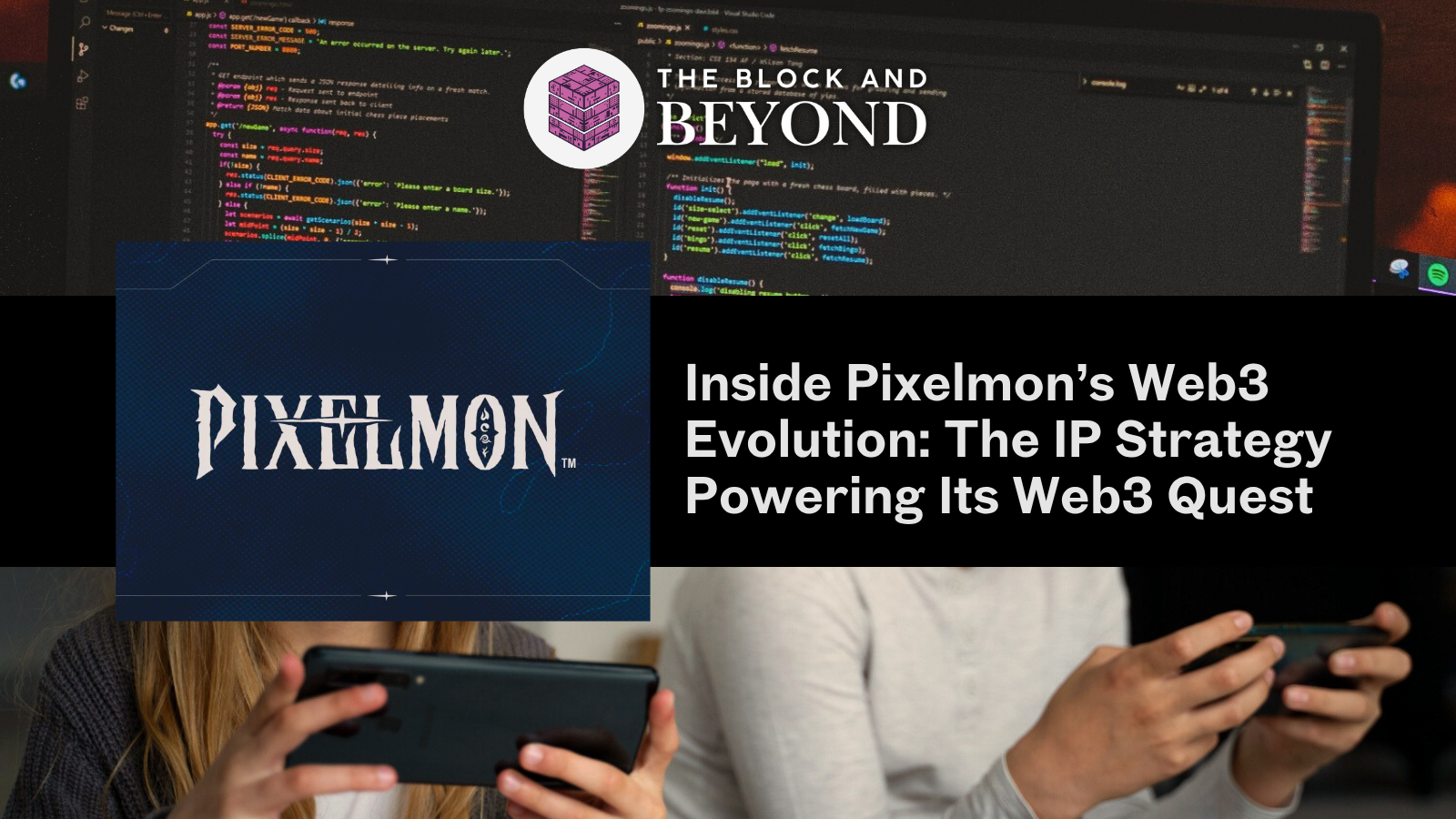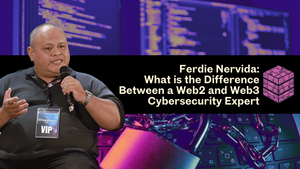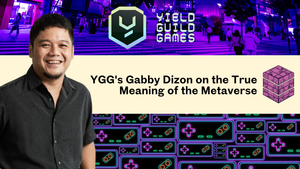What MON Co.’s Pixelmon teaches us about building lasting Web3 brands through storytelling, iteration, and the power of cross-platform identity.
In the volatile world of Web3, where projects can rise and fall within days, building a sustainable brand is less about hype and more about direction. Pixelmon, once dismissed as a cautionary tale of NFT speculation, is proving that a powerful IP, when backed by strategy and sincerity, can rise again. Today, under MON Co. (previously LiquidX), Pixelmon is evolving into something far greater than an NFT drop. It’s becoming a fully-fledged cross-media franchise, powered by gameplay, storytelling, anime, and community vision.
The Block and Beyond sat down with Matthew Wong-Stewart, Marketing Lead for Gaming at MON Co., in Singapore for an exclusive scoop on how the team is reviving Pixelmon, not just as a Web3 game, but as a long-term, multi-format IP built for a new generation of fans.
Reimagining Pixelmon Begins
In early 2022, Pixelmon burst into the NFT scene with viral attention, but the initial delivery didn’t meet expectations. What followed was a massive shift in leadership and direction.
“Pixelmon was a very ambitious NFT project that captured a lot of hype… it quickly became that cautionary tale. Then our current CEO, Giulio Xiloyannis, took over and started to rebuild that core identity.”
Rather than abandoning the project, the new team committed to reimagining it by remodeling all characters except for the now-iconic “Kevin,” refining the IP, and planning a long-term roadmap.
“We’re going to launch games under the IP. We’re going to launch an anime series under the IP,” Stewart explained.
The new goal? Tap into the nostalgia of monster-collecting games like Pokémon and Digimon while giving players a more mature and immersive world to explore.
Why Pixelmon’s Strategy Starts with Play
For Stewart, launching games is the cornerstone of the Pixelmon revival.
“Gaming is one of those industries that has been exploding… unlike say comics or anime where you just consume the product, with games, you're engaged. You're immersed."
With multiple games and an anime being developed in parallel, Pixelmon’s roadmap echoes how giants like Riot Games or The Pokémon Company expanded their IPs across media. But Pixelmon is doing it at an accelerated pace.
“At Riot, Arcane took ten years. With Pixelmon, we’ve been doing this since 2022 and we’re already getting close to launch,” Stewart added.
The team is also experimenting with different formats, from playtests to short-form anime worldbuilding, to better understand what resonates. These insights feed back into development, marketing, and audience alignment.
Data-Informed, Not Data-Driven
One of the most striking philosophies behind Pixelmon’s evolution is its marketing discipline rooted in Stewart’s previous experience at Riot Games and Garena.
“The thing I loved the most was to be data informed, not data driven. Being data-driven means you do something because the numbers say so. Being data-informed means you understand why the numbers say so, and you adapt accordingly.”
This approach came from hard lessons. Stewart recalled a viral FIFA campaign at Garena that initially succeeded, until overuse and poor reward planning led to diminishing returns.
“The campaign worked, but we didn’t adjust. Being data-informed helped us slow down, redesign rewards, and rebuild engagement.”
At Pixelmon, this ethos guides how content is tested, iterated, and launched. Whether it’s understanding why a game test performed well or why an anime short resonated, the goal isn’t just numbers but meaning.
Anime x Gaming: A Natural Web3 Crossover
“It’s been proven time and time again. Arcane from League of Legends, The Witcher, Pokémon, Digimon... there’s a huge correlation between the two,” he said.
While Stewart primarily focuses on the gaming side, he recognizes the undeniable synergy between anime and gaming audiences. Pixelmon, built on a monster-collecting foundation, is primed to tap into both.
This cross-media strategy is both about fan service and smart marketing. By leveraging the emotional connection of anime and the engagement of gaming, Pixelmon positions itself as a lifestyle IP that spans formats and generations.
“We’re trying to touch on all those fundamental touchpoints that monster-collecting enthusiasts have always loved."
Tailoring for Web3: Different Audiences, Different Approaches
Marketing in Web3 means more than promotion. It’s about knowing who you’re talking to. For Matthew Wong-Stewart, the key is understanding that Web3 natives and traditional gamers have very different motivations.
“It’s not just about how you market. It’s about understanding what the audience wants,” Stewart said.
Web3 users are drawn to collectability, ownership, and identity-driven assets like NFTs. Gamers, on the other hand, prioritize gameplay, competition, and immersion. MON Co.’s strategy adapts to both, ensuring Pixelmon speaks to each without losing its core.
“It’s give and take. Sometimes you tweak the marketing, sometimes you tweak the product. You have to adapt,” he added.
That balance is helping Pixelmon connect with multiple communities, turning a fragmented audience into a shared ecosystem.
The Pixelmon Ecosystem: Games, Tokens, and Storytelling
Pixelmon’s revival is anchored by a growing content ecosystem. Its flagship mobile RPG, Warden’s Ascent, and idle game Nova Thera Chronicles offer monster-collecting gameplay across genres. Meanwhile, Pixelmon TCG brings fast-paced strategy to mobile, introducing new mechanics around HP exchange and mana balance.
All experiences are powered by $MON, the project’s utility and governance token, used for in-game transactions, staking, and community rewards. Paired with an upcoming anime series set in Nova Thera, Pixelmon’s cross-platform expansion is designed to unify storytelling, gameplay, and ownership into one living, evolving universe.
Building a Franchise with Limited Resources
Asked what he’d prioritize with limited resources, Stewart didn’t hesitate:
“I would launch a mobile game.”
Not only is mobile gaming massively accessible, but it’s also a gateway to global reach. With a solid game foundation, Pixelmon can explore other verticals like anime, merchandise, or even trading card games. It’s a strategic build-up, not a scattershot launch.
“You're immersed when it comes to gaming. You're engaged. That’s what will help propel an IP long into the future.”
A Blueprint for Web3 IP Builders
Pixelmon shift in direction is more than just a redemption arc. It’s a case study in Web3 IP development. From data-informed iteration to cross-media expansion and audience-centered marketing, the franchise is setting new standards for how to build lasting digital worlds.
Its journey serves as a powerful reminder: virality fades, but vision compounds. In a world obsessed with overnight success, Pixelmon is betting on something else: longevity through storytelling, structure, and soul.










